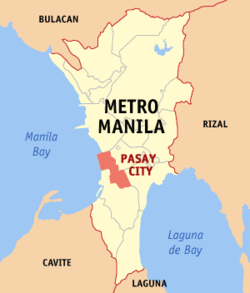Pasay
| Pasay | |||||
|---|---|---|---|---|---|
| Highly urbanized city | |||||
From left-to-right, top-to-bottom: Aliw Theater; Shrine of St. Therese, Doctor of the Church; Pasay City Hall
|
|||||
|
|||||
| Nickname(s): The Travel City | |||||
| Motto: Aim High Pasay! | |||||
 Location within Metro Manila |
|||||
| Location within the Philippines | |||||
| Coordinates: 14°33′N 121°00′E / 14.55°N 121°ECoordinates: 14°33′N 121°00′E / 14.55°N 121°E | |||||
| Country | Philippines | ||||
| Region | National Capital Region | ||||
| Districts | Lone District of Pasay City | ||||
| Incorporated | December 2, 1863 (town) | ||||
| Incorporated | June 21, 1947 (city) | ||||
| Highly Urbanized City | December 22, 1979 | ||||
| Barangays | 201 | ||||
| Government | |||||
| • Mayor | Antonino G. Calixto (Liberal) | ||||
| • Vice Mayor | Noel Del Rosario (Liberal) | ||||
| • Representative | Ma. Imelda G. Calixto-Rubiano (Liberal) | ||||
| • Sangguniang Panlungsod |
1st District
2nd District
|
||||
| Area | |||||
| • Total | 18.64 km2 (7.20 sq mi) | ||||
| Population (2015 census) | |||||
| • Total | 416,522 | ||||
| • Density | 22,000/km2 (58,000/sq mi) | ||||
| Demonym(s) | Pasayeño | ||||
| Time zone | PST (UTC+8) | ||||
| ZIP code | 1300–1309 | ||||
| Area code | +63 (0)2 | ||||
| Website | www |
||||
Pasay is one of the cities in Metro Manila, the National Capital Region of the Philippines. It is bordered to the north by the City of Manila, Makati to the northeast, Taguig to the east, and Parañaque to the south. Due to its location just south of the City of Manila, Pasay quickly became an urban town during the American Colonial Period.
The Namayan was a confederation of barangays which reached its zenith c. 1175. Its ruler, whose capital was at Sapa (today part of Santa Ana, Manila), controlled territory stretching from Manila Bay to Laguna de Bay. Dayang-dayang Pasay, presumably a royal or noble of the realm, is noted as having inherited lands in what is now Culi-culi, Pasay, and Baclaran, marking the area as subject to Namayan.
The Portuguese explorer Ferdinand Magellan arrived in what is now the Philippines on March 16, 1521. On May 19, 1571, Miguel López de Legaspi took formal possession of the Kingdom of Maynila and its surrounding polities in the name of the Spanish Crown. For 250 years, the Islands were governed by the Viceroy of Mexico, but in practise Catholic clergymen governed local politics.
Of the many religious orders that came, it was the Augustinian Order who would figure predominantly in the evangelisation of Pasay. The parish of Pasay was governed from the old Namayan capital, since renamed Sta. Ana de Sapa, which was under the jurisdiction of the Franciscans. The promise of space in Heaven prompted early native converts to donate their possessions to the Church, with folklore recounting how a baptised Pasay on her deathbed donated her vast estate to the Augustinians. Most of Pasay went to friar hands either via donation or by purchase; many natives were also forced to divest of their properties to cope with stringent colonial impositions. In 1727, the Augustinians formally took over Pasay and attached it to the Parish of Nuestra Señora de los Remedios in Malate. In that year, Pasay was renamed Pineda in honour of Don Cornelio Pineda, a Spanish horticulturist.
...
Wikipedia





